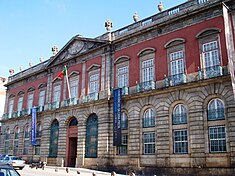Palace of the Carrancas
| Palace of the Carrancas (Palácio dos Carrancas) | |
| Soares dos Santos National Museum | |
| Palace (Palácio) | |
|
A view of the former-Palace of the Carrancas, home to the Soares dos Santos National Museum
|
|
| Official name: Palácio das Carrancas/Museu Nacional Soares dos Reis | |
| Country | |
|---|---|
| Region | Norte |
| Subregion | Grande Porto |
| District | Porto |
| Municipality | Porto |
| Location | Cedofeita, Santo Ildefonso, Sé, Miragaia, São Nicolau e Vitória |
| - coordinates | 41°8′51.85″N 8°37′17.56″W / 41.1477361°N 8.6215444°WCoordinates: 41°8′51.85″N 8°37′17.56″W / 41.1477361°N 8.6215444°W |
| Architects | Joaquim da Costa Lima Sampaio, Luís Chiari, Vieira Portuense, Fernando Távora |
| Materials | Granite, Marble, Wood, Masonry, Stucco, Tile |
| Origin | 18th century |
| - Initiated | 1795 |
| Owner | Portugal |
| For public | Private |
| Visitation | Closed |
| Easiest access | Rua de D. Manuel II; near the Rua Adolfo Casais Monteiro |
| Management | Instituto Gestão do Patrimonio Arquitectónico e Arqueológico |
| Operator | Direção Geral do Património Cultural (Decree 114/2012, Diário da República, Série 1, 102 (25 May 2012) |
| Status |
Property of Public Interest Imóvel de Interesse Público |
| Listing | Decree 24/003, Diário do Governo, Série 1, 136 (12 June 1934); Special Protection Zone non aedificandi, Dispatch, Diário do Governo, Série 2, 73 (27 March 1962) |
The Palace of the Carrancas (Portuguese: Palácio das Carrancas/Museu Nacional Soares dos Reis) is a former-residence in the civil parish of Cedofeita, Santo Ildefonso, Sé, Miragaia, São Nicolau e Vitória, in the northern Portuguese city of Porto.
In the 18th century, D. Brites Maria Felizarda de Castro acquired a series of lots in order to build a great house for a residence and to be able to establish a factory in 1795. The project was attributed to Joaquim da Costa Lima Sampaio, and architect who had previously worked on the building of the Hospital of Santo António and the Feitoria Inglesa (British Factory House), Neo-Palladian buildings designed by English architects based in Porto. This influence explains the style of the Palace, which follows the Neoclassical style that characterised late 18th and 19th-century architecture in Porto. The interior of the palace was decorated with stucco work attributed to the Italian Luis Chiari as well as wall paintings.
Between 1800 and 1801, the family Moraes e Castro moved to the location, bringing to the location not only a coat-of-arms, but also a nickname to the site associated with them: the Carrancas, which means scowls/frowns.
During the course of the Peninsular Wars, in 1808, the building became the official residence of the Corregedor-mor Tamboreau and General Marquez de Valladares, and in the following year (1809) the residences of General Soult and, later, headquarters of General Wellesley.
Similarly, it was the residence of General Beresford following the Peninsular Warm, and during the Siege of Porto (1832), King Peter IV used the palace as his headquarters for four months. In 1861, though, there was a promissory note to sell the palace by D. Pedro V.
...
Wikipedia

